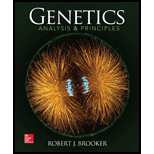
Concept explainers
Which changes in chromosome structure cause a change in the total amount of genetic material, and which do not?
To review:
The changes in a chromosomal structure that cause a change in the total amount of genetic material.
Introduction:
A chromosome is a highly-coiled and condensed DNA (deoxyribonucleic acid) structure, having protein molecules in it, which is present in the nucleus of the cell of an animal. A single piece of coiled DNA consists of many genes, other nucleotide sequences, and regulatory elements.
Explanation of Solution
The proteins involved in the packing of chromosomes are called histones. During the formation of egg or sperm cells, structural changes in the chromosome occur due to the DNA rearrangement. The changes which occur structurally are duplication, isochromosome formation, dicentric chromosome formation, translocation, and deletion.
For example, deletion refers to the process when chromosomes break and lose their genetic material. Deletions can occur in any amount and anywhere on a chromosome. One of thetype of change in chromosomal structure, in which the amount of genetic material is not affectedis called inversion. In this, a change in the direction of genetic material occurs along a chromosome.
In translocation, a piece of DNA attaches to a different part of the same chromosome or to a different chromosome. The total amount of genetic material does not change in simple and reciprocal translocation. Duplication results in the repeat of certain amount of genetic material and deficiencies result in the shortage of genetic material.
Therefore, it can be concluded that duplication, isochromosome formation, dicentric chromosome formation, translocation, and deletion change the amount of genetic material while the changes which do not affect the amount of genetic material are duplication and inversion.
Want to see more full solutions like this?
Chapter 8 Solutions
Genetics: Analysis and Principles
- In one paragraph show how atoms and they're structure are related to the structure of dna and proteins. Talk about what atoms are. what they're made of, why chemical bonding is important to DNA?arrow_forwardWhat are the structure and properties of atoms and chemical bonds (especially how they relate to DNA and proteins).arrow_forwardThe Sentinel Cell: Nature’s Answer to Cancer?arrow_forward
- Molecular Biology Question You are working to characterize a novel protein in mice. Analysis shows that high levels of the primary transcript that codes for this protein are found in tissue from the brain, muscle, liver, and pancreas. However, an antibody that recognizes the C-terminal portion of the protein indicates that the protein is present in brain, muscle, and liver, but not in the pancreas. What is the most likely explanation for this result?arrow_forwardMolecular Biology Explain/discuss how “slow stop” and “quick/fast stop” mutants wereused to identify different protein involved in DNA replication in E. coli.arrow_forwardMolecular Biology Question A gene that codes for a protein was removed from a eukaryotic cell and inserted into a prokaryotic cell. Although the gene was successfully transcribed and translated, it produced a different protein than it produced in the eukaryotic cell. What is the most likely explanation?arrow_forward
- Molecular Biology LIST three characteristics of origins of replicationarrow_forwardMolecular Biology Question Please help. Thank you For E coli DNA polymerase III, give the structure and function of the b-clamp sub-complex. Describe how the structure of this sub-complex is important for it’s function.arrow_forwardMolecular Biology LIST three characteristics of DNA Polymerasesarrow_forward
 Biology (MindTap Course List)BiologyISBN:9781337392938Author:Eldra Solomon, Charles Martin, Diana W. Martin, Linda R. BergPublisher:Cengage Learning
Biology (MindTap Course List)BiologyISBN:9781337392938Author:Eldra Solomon, Charles Martin, Diana W. Martin, Linda R. BergPublisher:Cengage Learning Human Biology (MindTap Course List)BiologyISBN:9781305112100Author:Cecie Starr, Beverly McMillanPublisher:Cengage Learning
Human Biology (MindTap Course List)BiologyISBN:9781305112100Author:Cecie Starr, Beverly McMillanPublisher:Cengage Learning Human Heredity: Principles and Issues (MindTap Co...BiologyISBN:9781305251052Author:Michael CummingsPublisher:Cengage Learning
Human Heredity: Principles and Issues (MindTap Co...BiologyISBN:9781305251052Author:Michael CummingsPublisher:Cengage Learning Principles Of Radiographic Imaging: An Art And A ...Health & NutritionISBN:9781337711067Author:Richard R. Carlton, Arlene M. Adler, Vesna BalacPublisher:Cengage Learning
Principles Of Radiographic Imaging: An Art And A ...Health & NutritionISBN:9781337711067Author:Richard R. Carlton, Arlene M. Adler, Vesna BalacPublisher:Cengage Learning





